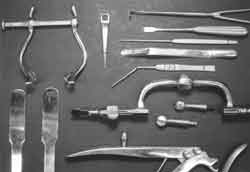|

In the 1930s, Portuguese neurologist Egas Monitz pioneered the lobotomy--a procedure in which the brain's frontal lobe nerves are severed by inserting tools through the eye socket. Widely accepted as a treatment for mental illness through the 1950s, the process attempted to control various behaviors by altering the section of the brain affecting social conduct. At Fulton, the philosophy of treating mental illness aggressively sometimes meant lobotomy. An elaborate system of checks, including interviews with social workers, psychologists, psychiatrists, and the patient, ensured that the irreversible operation was absolutely essential. The hospital performed its last lobotomy in 1966; psychiatric drugs made the method obsolete.
 Surgical Instruments used in performing lobotomies Surgical Instruments used in performing lobotomies
Glore Psychiatric Museum
|